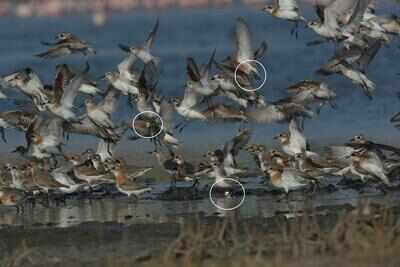
Nagpur: Bird watching is not only an engaging and knowledge-oriented hobby but is also equally fascinating and full of wonders. Young bird watcher Vedant Kasambe felt this exhilarating sense of achievement when he recorded 57 birds with coloured bands and rings during his birding excursion in the wetlands of Navi Mumbai in one single day.
There were alphanumeric codes on these bands. These tagged bird sightings were meticulously tabulated by Vedant, a volunteer with BNHS. The method of marking individual birds with bands or colour tags to study migration patterns dates back a century.
The most convenient method is bird ringing in which a bird is captured and a metal ring engraved with a unique serial number is fixed on the leg of the bird. This allows for easy identification later. When a bird with a tag is later recovered, it helps to establish a connection between two distant sites the bird visited. It also helps provide information on the lifespan and movement tendency of the bird.
“Following this method, BNHS has been able to establish connectivity for birds ringed in India through 3,000 recoveries with sites in 29 countries spanning five continents. In addition to ringing, BNHS has adopted the more recent methods of banding birds with colour bands, colour flags and neck-collars following international protocols,” said Bilwada Kale-Baxi, consultant PRO, BNHS.
The sighting records of colour tagged birds reported by ornithologists and photographers have yielded interesting results on movement of water birds and established links between migratory birds wintering in India. In the past year, 37 colour tag sighting records sent by birdwatchers from wetlands near Jamnagar have shed light on the seasonality of movement of migratory birds.
Additionally, two Greater Flamingos colour banded in Khijadiya, Gujarat, were recorded dispersing to other sites in the following season, presumably owing to the drought conditions at the tagging site. One of these individuals was recorded in Bikaner (Rajasthan) and another in a wetland in Mumbai.
Along with substantial ringing recovery records for Chilika Lake, Odisha, and Point Calimere, Tamil Nadu, shorebirds colour flagged at these sites were recorded in coastal wetlands in China and South Korea during their return migration journey. Similar studies in Pong Dam at Himachal Pradesh and Chilika Lake geese fitted with neck collars gave interesting records of changing wintering grounds and connectivity with their breeding grounds in China and Mongolia.
“During the migratory season of 2018-19 extensive efforts were made by BNHS team in colour tagging shorebirds in the wetlands around Mumbai. So far, the team has successfully tagged 3,906 waders and 39 flamingos between August 2018 to May 2019. Owing to these efforts, what is normally a rare event, sighting of a tagged bird is now becoming more common sight in Mumbai area,” Baxi informed.
The compilation of multiple bird sightings provide great insights into the population dynamics and seasonality of movement of migratory birds. Such data is being collected and compiled at BNHS since many years under its efforts for studying birds and their migration.
BNHS has appealed to all bird watchers to send data of their encounters with tagged birds by capturing an image or recording the tag number. To ease the data gathering and in view of making it more accessible to bird watchers, BNHS plans to develop a user-friendly android application for collecting data.
There were alphanumeric codes on these bands. These tagged bird sightings were meticulously tabulated by Vedant, a volunteer with BNHS. The method of marking individual birds with bands or colour tags to study migration patterns dates back a century.
The most convenient method is bird ringing in which a bird is captured and a metal ring engraved with a unique serial number is fixed on the leg of the bird. This allows for easy identification later. When a bird with a tag is later recovered, it helps to establish a connection between two distant sites the bird visited. It also helps provide information on the lifespan and movement tendency of the bird.
“Following this method, BNHS has been able to establish connectivity for birds ringed in India through 3,000 recoveries with sites in 29 countries spanning five continents. In addition to ringing, BNHS has adopted the more recent methods of banding birds with colour bands, colour flags and neck-collars following international protocols,” said Bilwada Kale-Baxi, consultant PRO, BNHS.
The sighting records of colour tagged birds reported by ornithologists and photographers have yielded interesting results on movement of water birds and established links between migratory birds wintering in India. In the past year, 37 colour tag sighting records sent by birdwatchers from wetlands near Jamnagar have shed light on the seasonality of movement of migratory birds.
Additionally, two Greater Flamingos colour banded in Khijadiya, Gujarat, were recorded dispersing to other sites in the following season, presumably owing to the drought conditions at the tagging site. One of these individuals was recorded in Bikaner (Rajasthan) and another in a wetland in Mumbai.
Along with substantial ringing recovery records for Chilika Lake, Odisha, and Point Calimere, Tamil Nadu, shorebirds colour flagged at these sites were recorded in coastal wetlands in China and South Korea during their return migration journey. Similar studies in Pong Dam at Himachal Pradesh and Chilika Lake geese fitted with neck collars gave interesting records of changing wintering grounds and connectivity with their breeding grounds in China and Mongolia.
“During the migratory season of 2018-19 extensive efforts were made by BNHS team in colour tagging shorebirds in the wetlands around Mumbai. So far, the team has successfully tagged 3,906 waders and 39 flamingos between August 2018 to May 2019. Owing to these efforts, what is normally a rare event, sighting of a tagged bird is now becoming more common sight in Mumbai area,” Baxi informed.
The compilation of multiple bird sightings provide great insights into the population dynamics and seasonality of movement of migratory birds. Such data is being collected and compiled at BNHS since many years under its efforts for studying birds and their migration.
BNHS has appealed to all bird watchers to send data of their encounters with tagged birds by capturing an image or recording the tag number. To ease the data gathering and in view of making it more accessible to bird watchers, BNHS plans to develop a user-friendly android application for collecting data.
Elections 2019
Trending Topics
LATEST VIDEOS
More from TOI
Navbharat Times
Featured Today in Travel
Quick Links
Lok Sabha Election Schedule 2019Lok Sabha Election NewsDelhi Capitals teamMI team 2019Rajasthan Royals 2019RCB team 2019Maharashtra Lok Sabha ConstituenciesBJP Candidate ListBJP List 2019 TamilnaduShiv Sena List 2019AP BJP List 2019Mamata BanerjeeBJP List 2019 MaharashtraPriyanka GandhiBJP List 2019 KarnatakaAMMK Candidate List 2019BJP List 2019 WBLok Sabha Elections in Tamil NaduBSP List 2019 UPNews in TamilLok Sabha Poll 2019Satta Matka 2018PM ModiMahagathbandhanNagpur BJP Candidate ListChandrababu NaiduTamil Nadu ElectionsUrmila MatondkarNews in TeluguMadras High CourtTejashwi YadavArvind KejriwalTejasvi SuryaPawan KalyanArvind KejriwalYogi AdityanathJaya PradaSatta King 2019Srinagar encounter
Get the app







